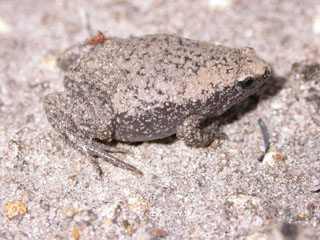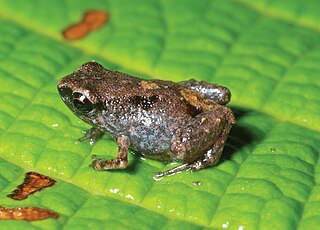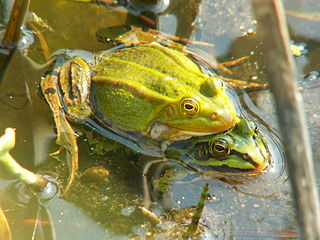
The true frogs, family Ranidae, have the widest distribution of any frog family. They are abundant throughout most of the world, occurring on all continents except Antarctica. The true frogs are present in North America, northern South America, Europe, Africa, and Asia. The Asian range extends across the East Indies to New Guinea and a single species has spread into the far north of Australia.

The Microhylidae, commonly known as narrow-mouthed frogs, are a geographically widespread family of frogs. The 683 species are in 63 genera and 11 subfamilies, which is the largest number of genera of any frog family.

Rana is a genus of frogs commonly known as the Holarctic true frogs, pond frogs or brown frogs. Members of this genus are found through much of Eurasia and western North America. Many other genera were formerly included here. These true frogs are usually largish species characterized by their slim waists and wrinkled skin; many have thin ridges running along their backs, but they generally lack "warts" as in typical toads. They are excellent jumpers due to their long, slender legs. The typical webbing found on their hind feet allows for easy movement through water. Coloration is mostly greens and browns above, with darker and yellowish spots.

Asterophryinae is a subfamily of microhylid frogs distributed in an area from the Peninsular Malaysia through the Malay Archipelago to northern Australia.

Polypedates is a genus of frogs in the family Rhacophoridae, the shrub frogs and Paleotropic tree frogs. They belong to subfamily Rhacophoridae. Members of this genus are collectively known as whipping frogs. They occur in eastern and southern Asia.

Kurixalus is a genus of frogs in the family Rhacophoridae. The taxonomy of small rhacophids is difficult and has been subject to many revisions, but molecular genetic data do support monophyly of Kurixalus. These frogs are distributed from Himalayan front ranges of eastern India southward and eastward to Cambodia, Vietnam, southern China, Taiwan, and the Ryukyu Islands.

Ingerana is a genus of frogs in family Dicroglossidae. These frogs are distributed in southeastern Asia, from Nepal, northeastern India, and southwestern China to Indochina, Borneo, and the Philippines. They are sometimes known as the eastern frogs.

Boana is a genus of frogs in the family Hylidae. They are commonly known as gladiator frogs, gladiator treefrogs or Wagler Neotropical treefrogs. These frogs are distributed in the tropical Central and South America from Nicaragua to Argentina, as well as in the Caribbean.

Phrynobatrachus is a genus of Sub-Saharan frogs that form the monogeneric family Phrynobatrachidae. Their common name is puddle frogs, dwarf puddle frogs, African puddle frogs, or African river frogs. The common name, puddle frog, refers to the fact that many species breed in temporary waterbodies such as puddles.

Nidirana adenopleura is a species of frog in the family Ranidae. It is found in Taiwan, south-eastern China, and in the Yaeyama Islands. Populations from Yaeyama Islands might represent a distinct, as yet undescribed species. The records from Vietnam and Thailand are uncertain.
The Emei music frog is a species of frog in the family Ranidae. It is endemic to China, and is found in central China, in southeastern Sichuan, northeastern Yunnan and western Guizhou provinces. The species name refers to the type locality, Mount Emei in Sichuan, and its vocalizing abilities. The original name Rana musica was replaced with Rana daunchina as the former name was already taken.

Holst's frog is a species of frog in the family Ranidae. It is endemic to the Ryukyu Islands of Japan. It occurs on mountains of the Okinawa and Tokashiki islands. It lives in primary or recovered secondary broad-leaved evergreen forests. It is threatened by habitat loss caused by road and dam construction.
The Otton frog, is a species of frog in the family Ranidae. It is endemic to the islands of Amami Ōshima and Kakeromajima in the Ryukyu Islands, Japan. Its natural habitats are subtropical or tropical moist lowland forests, freshwater marshes, and intermittent freshwater marshes. Once considered a delicacy as a source of food, it is now threatened by habitat loss through deforestation, and predation by introduced mongooses.

Pelophylax is a genus of true frogs widespread in Eurasia, with a few species ranging into northern Africa. This genus was erected by Leopold Fitzinger in 1843 to accommodate the green frogs of the Old World, which he considered distinct from the brown pond frogs of Carl Linnaeus' genus Rana.

Natalobatrachus bonebergi, the Natal diving frog, Boneberg's frog, or Kloof frog ), is a species of frog in the family Pyxicephalidae. It is the only species within the monotypic genus Natalobatrachus. It is endemic to South Africa. Its natural habitats are temperate forests and rivers and it is threatened by habitat loss.
Nidirana chapaensis, commonly known as the Chapa frog or glandular-sided frog, is a species of frog in the family Ranidae. It is found in Laos, Vietnam, and Thailand, although records from Thailand may refer to Nidirana lini.
Nidirana hainanensis is a species of frog in the family Ranidae. It is endemic to Hainan Island, China. Described in 2007, it is only known from its type locality, Mount Diaoluo in Lingshui Li Autonomous County. It most closely resembles Nidirana adenopleura, a more widespread frog from southern and south-eastern China and Taiwan.













